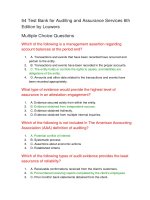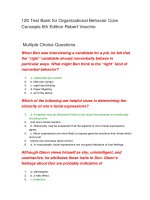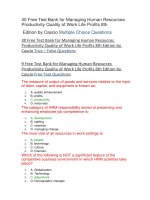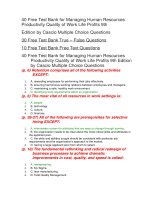Test bank for strategic human resources planning 6th edition by belcourt
Bạn đang xem bản rút gọn của tài liệu. Xem và tải ngay bản đầy đủ của tài liệu tại đây (216.95 KB, 16 trang )
Test Bank for Strategic Human Resources Planning 6th Edition by Belcourt
Full
file at />Name:
Class:
Date:
CHAPTER 1 - STRATEGIC MANAGEMENT
1. In order to achieve success implementing change, what two concepts do HR managers need to match together?
a. motivation and hiring practices
b. position modules and salary theories
c. principles and salary theories
d. HRM practices and organizational goals
ANSWER: d
2. What type of strategy is an agreed-upon plan that is arrived at through formal planning processes?
a. discarded
b. emergent
c. realized
d. intended
ANSWER: d
3. Managers in a department store have decided that the shoe department is not a profitable part of the store and that
it would be better suited to being an independent organization that rented space from the store. What type of
strategy is demonstrated if the shoe department is separated from the department store into a separate entity?
a. merger
b. divestiture
c. bankruptcy
d. growth
ANSWER: b
4. What type of objective is represented by the ratio “return on investment?”
a. soft
b. short-term
c. long-term
d. hard
ANSWER: d
5. What are the two primary types of inputs that influence an organization’s competitive advantage?
a. profitability and human capital
b. reputation and superior performance
c. culture and distinct advantage
d. capabilities and tangible assets
ANSWER: d
Copyright Cengage Learning. Powered by Cognero.
Full file at />
Page 1
Test Bank for Strategic Human Resources Planning 6th Edition by Belcourt
Full
file at />Name:
Class:
Date:
CHAPTER 1 - STRATEGIC MANAGEMENT
6. What type of competency is represented by resources and capabilities that serve as a firm’s competitive
advantage?
a. core
b. central
c. cultural
d. collective
ANSWER: a
7. Which of the following represents either a growth or a stability strategy?
a. merger
b. turnaround
c. bankruptcy
d. liquidation
ANSWER: a
8. If employees understand the behaviours and performance levels that will be rewarded on the job, what type of
benefit is produced that will help managers formulate a strategy?
a. clarity
b. incentives
c. change
d. efficiency
ANSWER: b
9. What is a tangible corporate goal that represents a point of view about the competitive positions a company hopes
to build over a decade?
a. strategic plan
b. strategic intent
c. strategic implementation
d. strategic formulation
ANSWER: d
10. If a formulated plan is called an intended strategy, what strategy depicts the implemented plan?
a. intentional
b. ideal
c. realized
d. predicted
ANSWER: c
Copyright Cengage Learning. Powered by Cognero.
Full file at />
Page 2
Test Bank for Strategic Human Resources Planning 6th Edition by Belcourt
Full
file at />Name:
Class:
Date:
CHAPTER 1 - STRATEGIC MANAGEMENT
11. If an organization fails to engage in strategic planning, it will be burdened by many challenges. Which of the
following is NOT one of these challenges?
a. failure to involve senior managers and executives so that there is no buy-in
b. failure to use the plan as the guide to make decisions and evaluate performance
c. failure to align incentives and other HR policies to the achievement of strategy
d. failure to incorporate information generated from 360-degree reviews
ANSWER: d
12. Which strategy is synonymous with logical incrementalism?
a. intended
b. emergent
c. discarded
d. realized
ANSWER: b
13. If all organizations are different, what strategic concept demonstrates this reality?
a. solitary
b. unrivalled
c. exclusive
d. unique
ANSWER: d������������������������������������������������������������������������������������������������������������������������������������������������������������������������������������������������������������������������������������������������������������������������������������������������������������������������������������������������������������������������������������������������������������������������������������������������������������������������������������������������������������������������������������������������������������������������������������������������������������������������������������������������������������������������������������������������������������������������������������������������������������������������������������������������������������������������������������������������������������������������������������������������������������������������������������������������������������������������������������������������������������������������������������������������������������������������������������������������������������������������������������������������������������������������������������������������������������������������������������������������������������������������������������������������������������������������������������������������������������������������������������������������������������������������������������������������������������������������������������������������������������������������������������������������������������������������������������������������������������������������������������������������������������������������������������������������������������������������������������������������������������������������������������������������������������������������������������������������������������������������������������������������������������������������������������������������������������������������������������������������������������������������������������������������������������������������������������������������������������������������������������������������������������������������������������������������������������������������������������������������������������������������������������������������������������������������������������������������������������������������������������������������������������������������������������������������������������������������������������������������������������������������������������������������������������������������������������������������������������������������������������������������������������������������������������������������������������������������������������������������������������������������������������������������������������������������������������������������������������������������������������������������������������������������������������������������������������������������������������������������������������������������������������������������������������������������������������������������������������������������������������������������������������������������������������������������������������������������������������������������������������������������������������������������������������������������������������������������������������������������������������������������������������������������������������������������������������������������������������������������������������������������������������������������������������������������������������������������������������������������������������������������������������������������������������������������������������������������������������������������������������������������������������������������������������������������������������������������������������������������������������������������������������������������������������������������������������������������������������������������������������������������������������������������������������������������������������������������������������������������������������������������������������������������������������������������������������������������������������������������������������������������������������������������������������������������������������������������������������������������������������������������������������������������������������������������������������������������������������������������������������������������������������������������������������������������������������������������������������������������������������������������������������������������������������������������������������������������������������������������������������������������������������������������������������������������������������������������������������������������������������������������������������������������������������������������������������������������������������������������������������������������������������������������������������������������������������������������������������������������������������������������������������������������������������������������������������������������������������������������������������������������������������������������������������������������������������������������������������������������������������������������������������������������������������������������������������������������������������������������������������������������������������������������������������������������������������������������������������������������������������������������������������������������������������������������������������������������������������������������������������������������������������������������������������������������������������������������������������������������������������������������������������������������������������������������������������������������������������������������������������������������������������������������������������������������������������������������������������������������������������������������������������������������������������������������������������������������������������������������������������������������������������������������������������������������������������������������������������������������������������������������������������������������������������������������������������������������������������������������������������������������������������������������������������������������������������������������������������������������������������������������������������������������������������������������������������������������������������������������������������������������������������������������������������������������������������������������������������������������������������������������������������������������������������������������������������������������������������������������������������������������������������������������������������������������������������������������������������������������������������������������������������������������������������������������������������������������������������������������������������������������������������������������������������������������������������������������������������������������������������������������������������������������������������������������������������������������������������������������������������������������������������������������������������������������������������������������������������������������������������������������������������������������������������������������������������������������������������������������������������������������������������������������������������������������������������������������������������������������������������������������������������������������������������������������������������������������������������������������������������������������������������������������������������������������������������������������������������������������������������������������������������������������������������������������������������������������������������������������������������������������������������������������������������������������������������������������������������������������������������������������������������������������������������������������������������������������������������������������������������������������������������������������������������������������������������������������������������������������������������������������������������������������������������������������������������������������������������������������������������������������������������������������������������������������������������������������������������������������������������������������������������������������������������������������������������������������������������������������������������������������������������������������������������������������������������������������������������������������������������������������������������������������������������������������������������������������������������������������������������������������������������������������������������������������������������������������������������������������������������������������������������������������������������������������������������������������������������������������������������������������������������������������������������������������������������������������������������������������������������������������������������������������������������������������������������������������������������������������������������������������������������������������������������������������������������������������������������������������������������������������������������������������������������������������������������������������������������������������������������������������������������������������������������������������������������������������������������������������������������������������������������������������������������������������������������������������������������������������������������������������������������������������������������������������������������������������������������������������������������������������������������������������������������������������������������������������������������������������������������������������������������������������������������������������������������������������������������������������������������������������������������������������������������������������������������������������������������������������������������������������������������������������������������������������������������������������������������������������������������������������������������������������������������������������������������������������������������������������������������������������������������������������������������������������������������������������������������������������������������������������������������������������������������������������������������������������������������������������������������������������������������������������������������������������������������������������������������������������������������������������������������������������������������������������������������������������������������������������������������������������������������������������������������������������������������������������������������������������������������������������������������������������������������������������������������������������������������������������������������������������������������������������������������������������������������������������������������������������������������������������������������������������������������������������������������������������������������������������������������������������������������������������������������������������������������������������������������������������������������������������������������������������������������������������������������������������������������������������������������������������������������������������������������������������������������������������������������������������������������������������������������������������������������������������������������������������������������������������������������������������������������������������������������������������������������������������������������������������������������������������������������������������������������������������������������������������������������������������������������������������������������������������ies of employees
ANSWER: c
43. If no two organizations are the same, then logically all organizational strategies are unique.
a. True
b. False
ANSWER: True
44. A company can have one corporate strategy but many business strategies.
a. True
b. False
ANSWER: True
45. When a company can no longer pay its creditors, the company may file for bankruptcy.
a. True
b. False
ANSWER: True
46. A vision statement would answer the questions “Who are we?” and “Why are we here?”
a. True
b. False
ANSWER: False
47. To be successful, a company must adopt only one corporate strategy.
a. True
b. False
ANSWER: False
48. The decision to merge with another company is an example of a growth strategy.
a. True
b. False
ANSWER: True
Copyright Cengage Learning. Powered by Cognero.
Full file at />
Page 10
Test Bank for Strategic Human Resources Planning 6th Edition by Belcourt
Full
file at />Name:
Class:
Date:
CHAPTER 1 - STRATEGIC MANAGEMENT
49. If an organization decides that the company is an ideal size and decides to maintain it, then the organization is
adopting a growth strategy.
a. True
b. False
ANSWER: True
50. Strategic intent is an intangible corporate goal.
a. True
b. False
ANSWER: False
51. Porter’s model of business strategy has been criticized for having categories that overlap.
a. True
b. False
ANSWER: True
52. There are three competitive positions used in most strategy textbooks: cost, differentiation, and flexibility.
a. True
b. False
ANSWER: False
53. The question, “Should we be in business?” is an example of a business strategy.
a. True
b. False
ANSWER: False
54. The strategic planning process is dynamic and evolves as environmental conditions change.
a. True
b. False
ANSWER: True
55. Examples of corporate strategy include decisions to compete internationally or to merge with other companies.
a. True
b. False
ANSWER: True
Copyright Cengage Learning. Powered by Cognero.
Full file at />
Page 11
Test Bank for Strategic Human Resources Planning 6th Edition by Belcourt
Full
file at />Name:
Class:
Date:
CHAPTER 1 - STRATEGIC MANAGEMENT
56. A discarded strategy is one that was found to be inappropriate because of changing circumstances.
a. True
b. False
ANSWER: True
57. In general, a restructuring strategy is one that deals with companies that are operating at a surplus and are typically
described as “money-making.”
a. True
b. False
ANSWER: False
58. Values guide the behaviour of individuals within an organization.
a. True
b. False
ANSWER: True
59. Hard objectives deal with social issues such as the ethics and values of an organization.
a. True
b. False
ANSWER: False
60. A “harvest” strategy can also be conceptualized as a “retrenchment” strategy because the goal is to restructure and
not grow.
a. True
b. False
ANSWER: True
61. Emergent strategy is the plan that changes incrementally due to environmental changes.
a. True
b. False
ANSWER: True
62. An acquisition is seen as two organizations joining to gain economies of scale, whereas a merger occurs when one
company acquires another.
a. True
b. False
ANSWER: False
Copyright Cengage Learning. Powered by Cognero.
Full file at />
Page 12
Test Bank for Strategic Human Resources Planning 6th Edition by Belcourt
Full
file at />Name:
Class:
Date:
CHAPTER 1 - STRATEGIC MANAGEMENT
63. Dynamic capabilities are the abilities of an organization to adapt and renew its competencies in accordance with a
changing business environment.
a. True
b. False
ANSWER: True
64. Competitive advantage of an organization includes the characteristics that enable it to earn higher rates of interest
on its investments than its competitors.
a. True
b. False
ANSWER: False
65. Opportunities and threats are environmental conditions external to the firm that have limited benefit and are
harmful to the organization.
a. True
b. False
ANSWER: False
66. “Core competencies” refers to the integrated knowledge sets within an organization that distinguish it from its
competitors and deliver value to customers.
a. True
b. False
ANSWER: True
67. SWOT analysis refers to the systematic and regular monitoring of environmental factors influencing the organization.
a. True
b. False
ANSWER: True
68. What is a corporate strategy? Identify the three major corporate or organization-wide strategies outlined by the
authors in the text and discussed in class and provide examples of each.
ANSWER: Corporate Strategies are focused on overall strategy for the company and its businesses or interests.
These strategies are usually focused on long-term growth and survival goals.
There are three corporate strategy options:
∙ Restructuring (turnaround, divestiture, liquidation, bankruptcy)
∙ Growth (incremental growth, international growth, mergers and acquisitions)
∙ Stability (maintain the status quo)
Copyright Cengage Learning. Powered by Cognero.
Full file at />
Page 13
Test Bank for Strategic Human Resources Planning 6th Edition by Belcourt
Full
file at />Name:
Class:
Date:
CHAPTER 1 - STRATEGIC MANAGEMENT
69. Compare and contrast corporate and business strategy. What is the difference between the two?
ANSWER: Business strategy focuses on one line of business as opposed to the overall corporation. Business
strategy involves building a strong competitive position as opposed to determining if this is the business
to be in. Business strategy is an action plan for managing one line of business. Corporate strategy asks,
“Should we be in business? What business should we be in?” Business strategy asks, “How should we
compete? Should we compete by offering products at prices lower than those of the competition or by
offering the best service?”
70. List the steps (from initial planning to end stages) in strategic planning.
ANSWER: 1. Establish the mission, vision, and values
2. Develop objectives
3. Analyze the external environment
4. Identify the competitive advantage
5. Determine the competitive position
6. Implement the strategy
7. Evaluate the performance
71. What are some of the benefits of strategy formulation to organizations? Identify and briefly describe five benefits.
ANSWER: ∙ Clarity – to help focus and guide decision-making about resource allocations
∙ Coordination – everyone working together towards the same goals
∙ Efficiency – daily decision-making guided toward the question “does it fit our strategy?”
∙ Incentives – employees understanding the behaviours and performance that will be rewarded
∙ Change – if major change is under consideration, then understanding current strategy is essential
∙ Career development – clear outline of organization’s strategy can help you decide if you want to work
for the company, if there is a skills fit, and what training and development you will need in order to
facilitate the achievement of strategy
∙ Understanding of the strategic planning process is the essential first step to creating an HR strategy
that makes sense for the organization
72. Compare and contrast the HRM practices of a company using a low-cost provider strategy with one using a
differentiation strategy.
ANSWER: Low-cost providers provide a product or service at a price lower than that of its competitors while
appealing to a broad range of customers. A major emphasis with this type of strategy is to reduce cost;
therefore, contingent workers are recruited and paid minimal hourly wages. There is a high turnover of
staff and minimal on-the-job training. There are minimal opportunities for career growth and
advancement. Businesses using a differentiation strategy seek to differentiate their products in ways that
will appeal to a broad range of buyers. More staff training may be required in businesses employing this
type of strategy. There is more emphasis on product knowledge and customer service. There may be
more opportunities for advancement in this type of business.
Copyright Cengage Learning. Powered by Cognero.
Full file at />
Page 14
Test Bank for Strategic Human Resources Planning 6th Edition by Belcourt
Full
file at />Name:
Class:
Date:
CHAPTER 1 - STRATEGIC MANAGEMENT
73. Cupcasions is a small bakery that crafts and sells gourmet cupcakes and cakes. Besides scanning and monitoring its
external environment, the managers also consider what competitive advantage the organization possesses—that is,
what characteristics enable them to generate more value for customers at a lower cost, thereby earning higher rates
of profit than its competitors. List the three categories of resources and describe one example of a resource that
Cupcasions would have that would allow them to perform more effectively or efficiently than its competitors.
ANSWER: Tangible assets: These are future economic resources that have substance and form from which an
organization will benefit. Examples are land, inventory, building, location, cash, and technology.
Intangible assets: These are future economic resources that have been generated from past
organizational events. These assets lack substance and form. Examples are human capital, reputation,
goodwill, trust, and copyright.
Capabilities: These are a complex combination of people and processes that represent the firm’s
capacity to exploit resources to achieve the firm’s objectives. Examples are managerial capabilities,
innovative capabilities, marketing capabilities, and organizational cultures.
74. According to the resource-based view, an organization’s sustained competitive advantage must meet four criteria.
List these four criteria.
ANSWER: 1. They are valuable to the firm’s strategy (they help generate value/reduce cost).
2. They are rare (competitors don’t have them).
3. They are inimitable (they cannot easily be copied by competitors).
4. They can be organized by the firm (the firm can exploit the resources)
75. With the information from external environment and internal competence analysis,
managers can summarize the conclusions using a SWOT analysis. What is a SWOT analysis?
ANSWER: A SWOT analysis is a tool for analyzing a company’s resource capabilities and deficiencies, its market
opportunities, and the external threats to its future. SWOT is an acronym for Strengths, Weaknesses,
Opportunities, and Threats. A strength is something that a company does well or an attribute that
makes it more competitive. A weakness is something that an organization does poorly, or a condition,
such as location, that puts it at a disadvantage relative to competitors. Opportunities and threats are
environmental conditions external to the firm that may be beneficial or harmful.
Copyright Cengage Learning. Powered by Cognero.
Full file at />
Page 15
Test Bank for Strategic Human Resources Planning 6th Edition by Belcourt
Full
file at />Name:
Class:
Date:
CHAPTER 1 - STRATEGIC MANAGEMENT
76. Describe one step in the strategic planning process. Identify an organization you are familiar with (such as from your
work experience or from the course textbook). Provide an example of how your chosen organization performs the
one strategic planning step.
ANSWER: 1. Establish the mission, vision, and values
2. Develop objectives
3. Analyze the external environment
4. Identify the competitive advantage
5. Determine the competitive position
6. Implement the strategy
7. Evaluate the performance
One Step: Analyze the external environment. To achieve the company’s objectives, managers must be
aware of threats and opportunities in the external environment. By scanning and monitoring technology,
laws and regulations, the economy, sociocultural factors, and changing demographics, managers can
make reactive and proactive changes to the strategic plan.
Copyright Cengage Learning. Powered by Cognero.
Full file at />
Page 16









